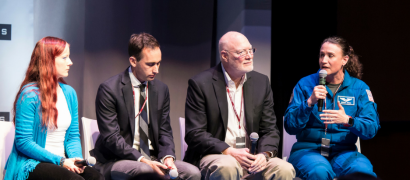
The possibilities are endless: a functioning economy on Mars, robots building structures in space, space stations with 3-D printers to replace broken equipment, farming vegetables on another planet.
The breadth of current space exploration and research—both by NASA and private-sector companies—is incredible.
Or, as Ellen Stofan, NASA’s chief scientist, concluded at the end of a panel discussion on humans living in outer space, “This is amazing. We really are on our way to Mars.”
The panel, “Not Just to Visit, but to Stay,” was part of today’s White House Frontiers Conference, hosted by the White House, the University of Pittsburgh, and Carnegie Mellon University. Panelists discussed current space-related technology and research, making it clear that living in outer space is no longer a pie-in-the-sky concept. Public- and private-sector scientists are researching the intricacies of sustaining life in space and on other planets.
“If you are trying to find evidence of past life on Mars, one or two rock samples won’t cut it. You will need a research lab on the planet and that will take a sustained presence,” said NASA’s Stofan.
Panelist Jason Dunn, cofounder of Made in Space, said he would like to see not only residents on Mars, but the creation of jobs there as well. Made in Space, based in Moffett Field, Calif., focuses on “off-world manufacturing,” or making things in space. The company has two 3D printers on the International Space Station, and provides commercial space manufacturing services to NASA, the federal government, and commercial users.
“We are looking at what can be made in space, and then become a product needed there or back on Earth. We could build a new economy,” Dunn said.
Another area crucial to sustaining life in outer space is maintaining sustainable sources of food, water and oxygen. Known as bioregenerative life systems, these self-contained ecosystems comprise humans, plants, and microbes. Learning how to create them successfully is one focus of research for panelist Heather Hava, a doctoral student in aerospace engineering at the University of Colorado Boulder and CEO of Stellar Synergetics. Hava has created two robots that can grow fruits and vegetables in space.
Her vision? “We could have robots in space interact with a mission crew in virtual reality” and the astronauts could eat the robot-tended food once they arrived at their destination, she said.
Check back throughout today and the week to for more about the White House Frontiers Conference.
—Jane-Ellen Robinet
